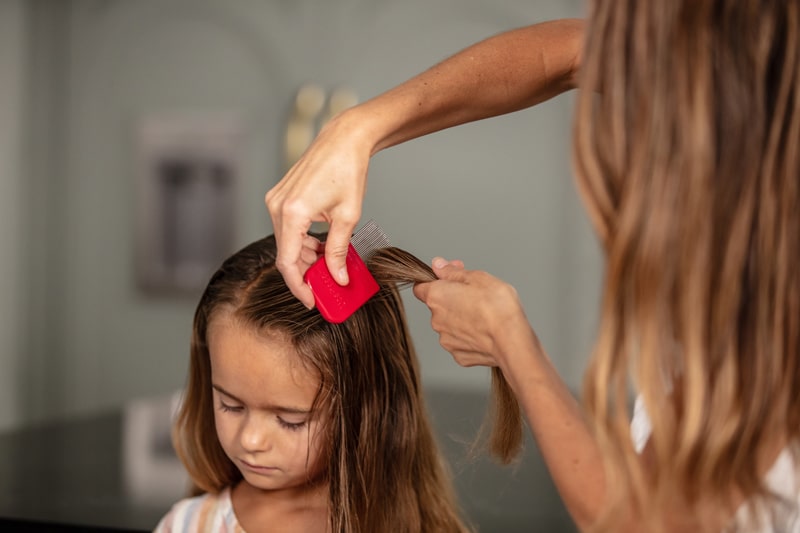Can You Have Nits Without Lice? An In-Depth Look at Head Lice Infestations
Head lice infestations can be a perplexing and frustrating experience, especially when you discover nits (head lice eggs) but no visible lice. This seemingly strange occurrence can leave you wondering about the state of the infestation and the effectiveness of your treatment efforts. In this comprehensive guide, we will delve into the reasons why nits can be present without live lice and provide you with a deeper understanding of head lice behavior, lifecycle, and effective management strategies.
Understanding Head Lice and Nits
Head lice are tiny, wingless parasites that live on the human scalp and feed on blood. The lifecycle of a louse begins with laying eggs, known as nits. These nits are attached to the hair shaft close to the scalp with a strong, glue-like substance, making them difficult to remove. Nits are oval and usually yellowish or white. They hatch into nymphs within 7-10 days, and these nymphs mature into adult lice over the next 9-12 days.
While adult lice and nymphs are mobile and can move quickly, nits remain stationary. This difference in behavior can lead to situations where nits are found without any visible lice. Here are several explanations for this phenomenon:

1. Houdini Lice
Head lice are experts at hiding. They have evolved to be incredibly elusive, which makes them challenging to detect. When you search for lice, they can quickly scurry away from the light and hide in the thicker parts of the hair, behind the ears, or at the nape of the neck. This behavior can make it seem like there are no live lice present, even when there is an active infestation.
Conduct thorough and systematic head checks to improve your chances of detecting lice. Part the hair in small sections and inspect each area carefully with a bright light and a fine-tooth lice comb, like the NitDuo Comb. Focus on lice’s preferred hideouts, such as behind the ears and at the nape of the neck. Be patient and persistent in your search.
2. Fell Overboard or Abandoned Ship
Another possibility is that the live lice have become dislodged from the hair. Lice can fall off the head during activities like brushing, combing, or washing the hair. Once dislodged, lice can survive for a short period but will eventually die without a host to feed on.
Additionally, lice can transfer to another person’s hair through direct contact or by sharing personal items such as hats, scarves, hairbrushes, and bedding. If lice have found a new host, they may have left behind nits in the original person’s hair.
3. Dead Nits
After treating a head lice infestation, it is common to find nits still attached to the hair. These nits may be dead or non-viable, meaning they will not hatch into nymphs. The presence of dead nits is often the result of effective treatment, which kills the live lice and nymphs but does not necessarily remove the nits.
It is challenging to determine whether a nit is dead or alive with the naked eye. However, nits that are more than a quarter inch away from the scalp are usually considered non-viable, as they have either hatched or are no longer alive. To ensure thorough removal, use a nit comb to systematically comb through the hair, removing as many nits as possible.

Additional Reasons for Finding Nits Without Lice
Aside from the primary reasons mentioned above, there are other factors that could explain the presence of nits without visible lice:
- Early Detection: You might have discovered the nits at the very early stages of an infestation before the lice have had a chance to mature and become more mobile. Early detection is crucial for effective treatment and prevention of a full-blown infestation.
- Post-Treatment Checks: After treating head lice, it is essential to conduct follow-up checks. Even the most effective treatments may not kill all nits. Conduct regular checks over the weeks following treatment to ensure that any surviving nits or newly hatched lice are promptly addressed.
- Environmental Control: Ensuring a clean environment can prevent re-infestation. Wash and dry clothing, bedding, and personal items on high heat settings. Vacuum carpets, furniture, and car seats to remove any dislodged lice or nits.
Preventing Future Infestations
Prevention is key to avoiding the frustration of head lice infestations. Here are some tips to help prevent lice from spreading:
- Educate Family Members: Teach family members about the importance of not sharing personal items that come into contact with hair. This includes hats, scarves, hairbrushes, and headphones.
- Regular Head Checks: Conduct regular head checks, especially during lice outbreaks at schools or daycare centers. Early detection can prevent a minor issue from becoming a major infestation.
- Hairstyles: Encourage children to wear their hair tied back in ponytails, braids, or buns during outbreaks to reduce the risk of hair-to-hair contact.
Finding nits without lice can be puzzling, but understanding the behavior and lifecycle of head lice can help clarify this situation. By being vigilant and thorough in your checks and treatments, you can effectively manage and prevent head lice infestations. Remember, persistence and attention to detail are essential. Consult a healthcare professional for further guidance if you have any doubts or concerns.
